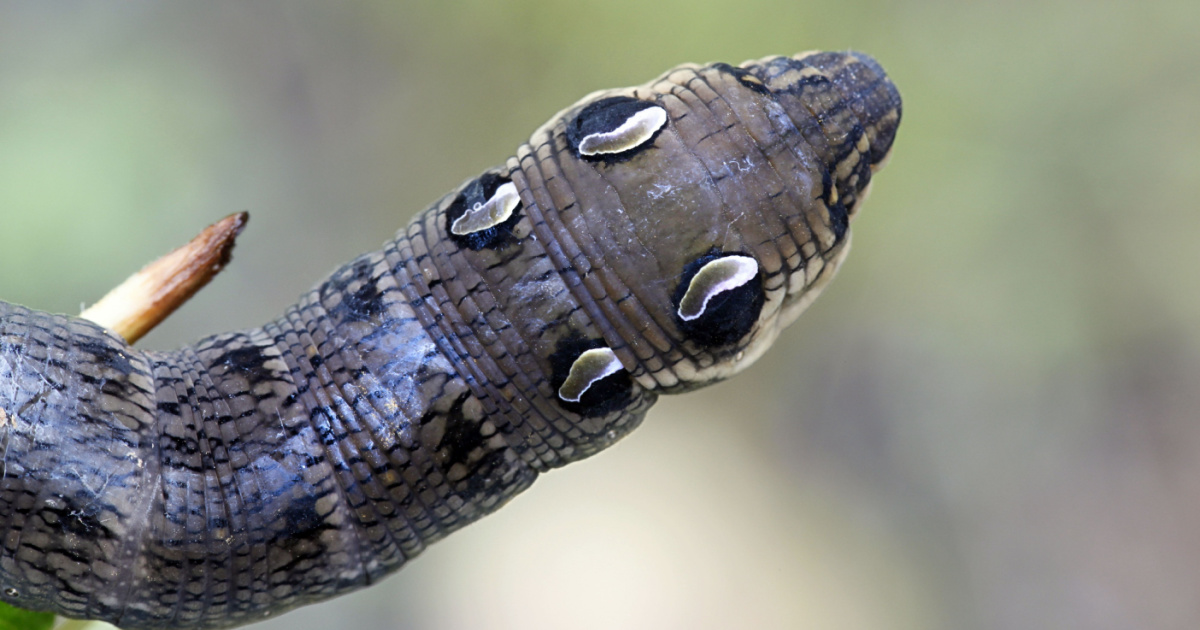Imagine how you would react if you were walking along and you suddenly saw what you thought was a dangerous, poisonous snake. Would you stand still and back away slowly, hoping to not provoke it? Or would you jump and run away screaming, getting out of there as fast as you can? Well, as it turns out if you see this particular creature, neither of those reactions would be necessary. No, this isn’t a venomous snake, it’s actually a harmless insect. The sight of a Hawk Moth caterpillar can be quite startling, with its vibrant colors and unique appearance. This is everything you didn’t know you needed to know about this fascinating bug.
Everything to Know About the Hawk Moth Caterpillar

The Hawk Moth Caterpillar is an amazing little creature. There are several different species of them, with some of them looking startling like a snake. Despite their perhaps frightening appearance, there is nothing harmful about them. These are some fun facts you didn’t know that you needed about this interesting insect. (1, 2, 3)
1. Impressive Camouflage Abilities

One of the most incredible features of Hawk Moth caterpillars is their ability to blend seamlessly with their surroundings. With their green or brown bodies adorned with intricate patterns, these caterpillars can effortlessly mimic leaves or twigs. This remarkable camouflage allows them to remain hidden from predators and increases their chances of survival.
2. The Peculiar Generational Journey
Hawk Moth caterpillars undergo a fascinating life cycle that starts with the female moth laying her eggs on a host plant. Once the caterpillar hatches, it embarks on a voracious feeding frenzy, consuming large quantities of leaves to fuel its growth. This larval stage can last for several weeks or even months, depending on the species. After reaching its full size, the caterpillar undergoes metamorphosis and transforms into a pupa or chrysalis. Inside this protective casing, it undergoes a remarkable transformation, eventually emerging as a stunning adult Hawk Moth.
3. Defense Mechanisms
While Hawk Moth caterpillars may seem harmless, they possess unique defense mechanisms to protect themselves from potential threats. Some species have horn-like structures called osmeteria that they can extend when threatened. These fleshy projections emit a foul odor that repels predators such as birds or small mammals. Additionally, certain species possess irritating spines or hairs that deter predators from attacking them.
4. Impressive Speed and Size

Hawk Moth caterpillars are known for their remarkable speed and growth. These caterpillars can move surprisingly quickly, despite their seemingly cumbersome bodies. Some species can reach sizes of up to four inches long, making them quite impressive in terms of both their speed and physical stature.
5. Mysterious Symbiotic Relationships
Hawk Moth caterpillars have evolved interesting symbiotic relationships with certain plants. For instance, the caterpillars of the Death’s-head Hawk Moth (Acherontia species) are able to consume and tolerate the toxic compounds found within potato and tomato plants. This unique adaptation allows them to feed on these plants without suffering any harmful effects.
6. Essential Pollinators
Beyond their captivating appearance and interesting behavior, Hawk Moth caterpillars play an essential role in the ecosystem as pollinators. Adult Hawk Moths have long tongues, or proboscises, that they use to access nectar from flowers. While feeding, they inadvertently pick up pollen on their bodies, transferring it from one flower to another. This unwitting act of pollination helps plants reproduce and contributes to the diversity and abundance of plant life.
The Bottom Line
The Hawk Moth caterpillar is a truly remarkable insect, capable of astonishing feats such as camouflage, defense mechanisms, and participating in essential ecological processes. Their vibrant colors, peculiar life cycle, and fascinating attributes make them a subject of great intrigue and fascination. So, the next time you encounter a Hawk Moth caterpillar, instead of screaming, take a moment to marvel at the wonders of nature that this harmless creature represents.
Keep Reading: Have silverfish in your home? You could have an expensive problem on your hands.
Sources
- “A convincing disguise transforms the hawk moth caterpillar into a small snake to ward off potential predators..” National Geographic. Elaina Zachos. April 3, 2018.
- “HAWK-MOTH CATERPILLAR IDENTIFICATION: EIGHT UK SPECIES.” Wood Land Trust. Amy Lewis. July 21, 2021.
- “Elephant hawk moth.” RHS

